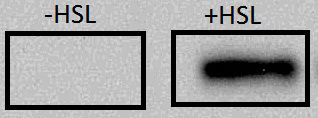Team:Washington/Gram Negative/Test
From 2010.igem.org
Western blotting for proper Tse2 expression
In order to determine that Tse2 and Tsi2 were only being produced in the presence of HSL, E. coli MG1655 containing the F2620-Tse2-Tsi2 construct was cultured in liquid LB containing either 10µM HSL, or no HSL. the cultures were pelleted, and western blotted for Tse2. The cultures grown in HSL+ media showed bands on the western blot (Figure x) indicative of Tse2 being produced when HSL is present. The cultures grown in media without HSL showed no bands ( Figure X), meaning that Tse2 is not being expressed unless HSL is present. This is exactly the behavior that was expected if the F2620-Tse2/Tsi2 system was working properly. The survival of cells in the HSL+ media despite the production of Tse2, combined with the sequence confirmation of Tse2 in the construct implies that Tsi2 is working as an antitoxin.
SDS-PAGE Protein Array
Fha1 (Forkhead-associated protein) is an essential component of the Type VI Secretion System. We confirmed the utility of our promoter insertion by using an SDS-PAGE assay with anti-Fha antibody to probe for expressed protein. The recombinant fosmid was transformed into a T7 expression strain, BL21(DE3), which produces T7 RNA polymerase in the presence of IPTG. The Fha1 protein was expressed under induced conditions. Though the band was light, it shows that the proteins are certainly expressing in our new E. coli system.
Further Characterization
Testing the Toxicity of Tse2
We had intended to determine the relative level of Tse2 expression required to cause cell death, and to compare the toxicity of Tse2 to [http://partsregistry.org/Part:BBa_P1010 ccdB]( the most commonly used cell death protein). This would require that both Tse2 and CcdB be placed downstream from the same, inducable promoter. Cell growth curves would then be measured at various levels of inducer. The toxin that is more toxic would kill at a lower concentration of inducer molecule ( and thus lower protein levels). We had intended to place both Tse2 and CcdB downstream from [http://partsregistry.org/Part:BBa_F2620 F2620] and compare growth at various HSL concentrations, but we were unable to obtain sequence verified F2620-Tse2 constructs due to mutations . This implies that leakiness from the pLux promoter is enough to create a selection advantage against even the smallest levels of Tse2 production. Conducting this test would require the use of a less leaky promoter that would only produce Tse2 when the inducer is present.
Testing the complete T6SS/ Tsi2/ Tse2 system
We were only able to show that the T6SS was being expressed, and that Tse2 was being expressed only when HSL is present. To show the entire system works would require that the T6SS can kill cells by injecting Tse2. This would be tested via competition assays. We would expect our probiotic to outcompete wild type E. coli when both the T6SS and Tse2/Tsi2 are being expressed (+HSL,+IPTG), but not when only the T6SS ( -HSL,+IPTG) or only Tse2/Tsi2 (+HSL, -IPTG) is being expressed.
 "
"


